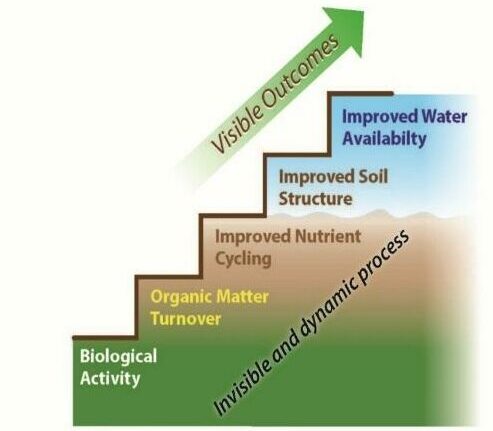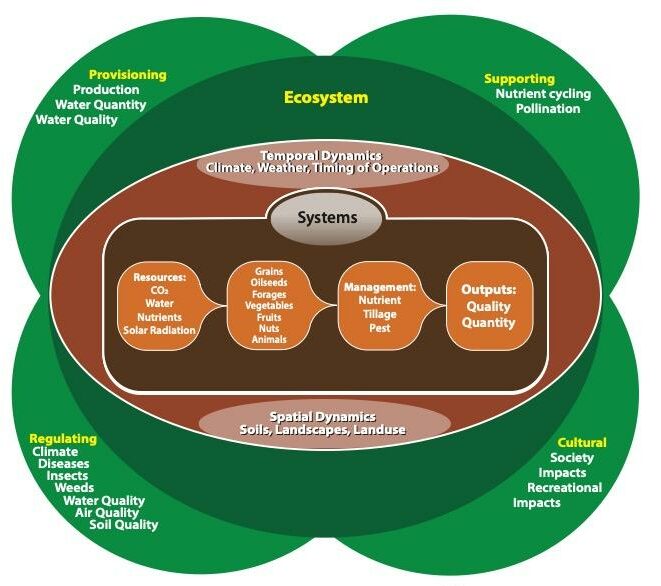There is an explosion of interest in carbon markets in agriculture, and it is difficult not to see, hear, or read something about these programs. While there remains a great deal of uncertainty about the market value for the carbon derived from agricultural practices, I believe that we should value carbon as the currency for changing soil health. We value dollars as the currency upon which we gauge our financial status, buy goods, save for retirement, or contribute to charity. We think about carbon as a deposit into the soil and need to realize that carbon supplies the energy required to change the soil and increase soil health. We need to think about depositing carbon into the soil like the way we think about our retirement accounts and focus our efforts on depositing money into the account, refrain from withdrawing the money until retirement, diversify the portfolio, and don’t look at the account every day or week. As we discover the value of carbon in the soil, we need to begin to understand the dynamics of carbon in the soil and its role in changing soil health.

Illustration 1: Soil Aggradation Climb
Carbon is the primary source of energy to feed biological activity in the soil. The air contains carbon dioxide (CO2) and through the photosynthetic process, CO2 is converted into a glucose, simple sugar. Glucose is the base for all the metabolic products (proteins, fats, lipids, oils) created in a plant. Many of these carbon products are transported from the leaves, through the stem, and down to and exuded out of the roots to provide liquid carbon energy for the soil microbes. All living organisms require energy to maintain, grow, and perform their functions, and microbes are no different. Changes in soil health begin with soil biology and I have used this simple diagram (Illustration 1) of soil change as a ladder in which the first step is soil biology and to facilitate this change there is a need for food (energy), water, air, and shelter (undisturbed environment). We need these four basic provisions for survival as living beings. To facilitate growth, we need a supply of energy in excess of maintenance. In terms we all understand, if we consume more calories than we require, we gain weight. Likewise, if we want to change the soil and increase soil health, we must find a way to supply more energy into the microbial communities. If we begin to think in terms of energy requirements, I believe we will begin to understand how the soil ecosystem is really connected to the plant component and begin to quantify what is required to increase and maintain soil health.

Carbon becomes the currency of change for soil health. Research (footnote 1) has found that microbes are the major driver of soil organic carbon changes in the soil. Because plants capture carbon from the CO2 portion of the air, convert it into sugars and then use that energy to sustain life in the soil, it is critical to understand how this energy is partitioned. Another interesting research article (Footnote 2), demonstrates that root exudate sugars affect and shape microbial activity within seconds. Exactly how much energy is required to change soil health attributes (aggregate stability or soil carbon content) remains a critical question. It is difficult to answer when we focus on measuring soil health parameters rather than the pathways and the processes that caused the change. When we consider that a biological system requires energy for maintenance and growth, then we can begin to ask the question about how much carbon energy is required for significant biological soil change. In other words, how much carbon currency needs to be added to the account to make a difference!
There are two ways to increase your bank savings account: (1) Earn and deposit more and (2) Spend and withdraw less. We can withdraw less carbon from our soil bank when we reduce or eliminate tillage intensity as the mechanical disturbance of the soil oxidizes carbon which is lost as CO2. We can deposit more carbon into the soil by increasing the length of time in which we capture CO2 and convert it into sugar by having plants growing longer. Many farmers are doing this with the incorporation of extended cash crop rotations and cover crops. In Ames, Iowa where I live, I estimate that I can capture up to 25% of total annual sunlight using a cover crop that grows from September (physiological maturity of corn) to November (winter dormancy) and then from March (dormancy break) to May (corn emergence). That is a huge amount of energy we can invest as carbon currency into our soil and biological portfolio!
Capturing carbon from growing plants and transporting it into the soil via the roots offers the potential to change the soil and ultimately affect ecosystem services. Our challenge going forward is to begin to link all the components of an agricultural system into a robust but complex framework. We have spatial variation across the landscape with depth into the soil profile and boundaries between fields. We also see temporal variation with time of day, season of the year, and the interaction with the changing physical environment. In agricultural systems, we tend to place the highest priority on what we produce and how much, but we need to start looking at our agricultural systems based on what we impact. Water quantity and quality, flood mitigation, air quality, diverse pollinator habitat, and the social and cultural value of our landscapes are all huge environmental impacts from the way that we farm.

Illustration 2
These complex interactions are shown graphically here in Illustration 2 as an agroecosystem and the linkage to ecosystem services. Ecosystem services depend upon the soil being able to support robust plant productivity and soil functions that enhance nutrient cycling, degradation of agrochemicals, and storage of soil water. Any change in soil functionality and ultimately soil health requires an input of energy. We need to go beyond measuring the changes in soil parameters and study what was needed to make and to sustain that change. The sooner we can bring together the observations focused on the energy dynamics in the soil, the faster we will be able to value carbon as a currency of change and discover the true value of carbon.
Footnote 1: (Wiesmeier, M., Urbanski, L., Hobley, et al., 2019. Soil organic carbon storage as a key function of soils – A review of drivers and indicators at various scales. Geoderma 333:149–162.)
Footnote 2: Gunina, A, & Kuzyakov Y (2015) Sugars in soils and sweets for microorganisms: Review of origin, content, composition, and fate. Soil Biology and Biochemistry 90:87-100
This article first appeared in the 9th Edition of Green Cover's Soil Health Resource Guide.
Also check out the 11th edition, our latest Soil Health Resource Guide, over 90 pages packed with scientific articles and fascinating stories from soil health experts, researchers, farmers, innovators, and more! All as our complimentary gift to you, a fellow soil health enthusiast!
